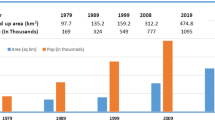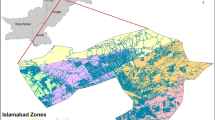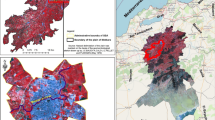Abstract
The present research relates to the exploitation of remote sensing and geographic data to study the metropolitan expansion, land use patterns and land cover classification of Islamabad. The metropolitan development based on growth direction and expansion trends from the city centre was observed for a period of 38 years. Landsat satellite data from three sensors, that is, multi-spectral sensor, thematic mapper and enhanced thematic mapper plus, were used in this study. The classification of the complex spatial assemblage of urban environment and its expanding precincts was done using temporal data collected during the period 1972–2009 and geo-referenced to a common coordinate system. The information regarding agriculture farms, bare land, dense forest, mixed vegetation, shadowy regime, sparse residential areas, thickly populated areas and water bodies was extracted. The extent of urban conurbation growth was computed and analyzed. Our results show that the urban development is expanded by 87.31 km2. In addition, the urban growth is accompanied by the loss of forest and other natural habitat in the city and has influenced the spatial patterns and structure of urban development. It is concluded that the remote sensing and GIS techniques supplemented with census data are very efficient and effective for studying the metropolitan growth patterns.

Similar content being viewed by others
References
Tapiador F., Casanova J.L.: Land cover mapping methodology using remote sensing for the regional planning directives in Segovia, Spain. Landsc. Urban Plan 62, 103–115 (2003)
Yang X.: Satellite monitoring of urban spatial growth in the Atlanta metropolitan area. Photogramm. Eng. Remote Sens 68, 725–734 (2002)
Madhavan B.B., Kubo S., Kurisaki N., Sivakumar N.: Appraising the anatomy and spatial growth of the Bangkok metropolitan area using a vegetation-impervious soil model through remote sensing. Int. J. Remote Sens 22, 789–806 (2001)
Ridd M.K., Liu J.: A comparison of four algorithms for change detection in an urban environment—a remote sensing perspective. Remote Sens. Environ. 63, 95–100 (1998)
Jensen, J.R.: Digital Change Detection. Introductory Digital Image Processing: A Remote Sensing Perspective, pp. 467–494. Prentice-Hall, New Jersey (2004)
Jensen, J.R.: Introductory Digital Image Processing: A Remote Sensing Perspective. Prentice Hall, Englewood Cliffs (1996)
Ehlers M., Jadkowski M.A., Howard R.R., Brostuen D.E.: Application of SPOT data for regional growth analysis and local planning. Photogramm. Eng. Remote Sens 56, 175–180 (1990)
Epstein J., Payne K., Kramer E.: Techniques for mapping suburban sprawl. Photogramm. Eng. Remote Sens 63, 913–918 (2002)
Treitz P.M., Howard P.J., Gong P.: Application of satellite and GIS technologies for land-cover and land-use mapping at the rural-urban fringe: a case study. Photogramm. Eng. Remote Sens. 58, 439–448 (1992)
Harris P.M., Ventura S.J.: The integration of geographic data with remotely sensed imagery to improve classification in an urban area. Photogramm. Eng. Remote Sens. 61, 993–998 (1995)
Sudhira H.S., Ramachandra T.V., Jagadish K.S.: Urban sprawl: metrics, dynamics and modeling using GIS. Int. J. Appl. Earth Obs. Geoinf. 5, 29–39 (2004)
Yang X., Liu Z.: Use of satellite derived landscape imperviousness index to characterize urban spatial growth. Comput. Environ. Urban Syst. 29, 524–540 (2005)
Haack B.N., Rafter A.: Urban growth analysis and modeling in the Kathmandu valley, Nepal. Habitat Int 30, 1056–1065 (2006)
Kaya S., Curran P.J.: Monitoring urban growth on the European side of the Istanbul metropolitan area: a case study. Int. J. Appl. Earth Obs. Geoinf 8, 18–25 (2006)
Weng Q.: A remote sensing-GIS evaluation of urban expansion and its impact on surface temperature in the Zhujiang Delta, China. Int. J. Remote Sens. 22, 1999–2014 (2001)
Bhattarai K., Conway D.: Urban vulnerabilities in the Kathmandu valley, Nepal: visualizations of human/hazard interactions. J. Geogr. Inf. Syst. 2, 63–84 (2010)
Haack B.: A history and analysis of mapping urban expansion in the Kathmandu valley, Nepal. Cartogr. J 46, 233–241 (2009)
Thapa, R.B.: Spatial process of urbanization in Kathmandu valley, Nepal. PhD Dissertation. Graduate School of Life and Environmental Sciences, University of Tsukuba, Ibaraki (2009)
Thapa, R.B.; Murayama, Y.: Urban growth modeling of Kathmandu metropolitan region, Nepal. Comput. Environ. Urban Syst. doi:10.1016/j.compenvurbsys.2010.07.005 (2010)
Lata K.M., Prasad V.K., Badrinath K.V.S., Raghavaswamy V., Rao C.H.S.: Measuring urban sprawl: a case study of Hyderabad. GIS Dev 5, 26–29 (2001)
Kamal A.S.M.M., Midorikawa S.: GIS-based geomorphological mapping using remote sensing data and supplementary geoinformation a case study of the Dhaka City area, Bangladesh. Int. J. Appl. Earth Obs. Geoinf 6, 111–125 (2004)
Taubenbock H., Wegmann M., Roth A., Mehl H., Dech S.: Urbanization in India—spatiotemporal analysis using remote sensing data. Comput. Environ. Urban Syst. 33, 179–188 (2009)
Jat M.K., Grag P.K., Khare D.: Monitoring and modeling of urban sprawl using remote sensing and GIS techniques. Int. J. Appl. Earth Obs. Geoinf 10, 26–43 (2008)
Dewan A.M., Yamaguchi Y.: Land use and land cover change in Greater Dhaka, Bangladesh: using remote sensing to promote sustainable urbanization. Appl. Geogr 29, 390–401 (2009)
Thapa R.B., Murayama Y.: Examining spatiotemporal urbanization patterns in Kathmandu valley,Nepal: remote sensing and spatial metrics approaches. Remote Sens 1, 534–556 (2009)
Doxiadis C.: Islamabad, the creation of a New Capital. Town Plan. Rev 36, 1–28 (1965)
Population Census Organization, Statistics Division, Government of Pakistan, 1998, District Census Report of Islamabad, Population Census Organization Press Islamabad
Fuller R.M., Groom G.B., Jones A.R.: The land cover map of Great Britain: an automated classification of Landsat Thematic Mapper data. Photogramm. Eng. Remote Sens 60, 553–562 (1994)
Townshend, J.R.G.: Effects of Spatial Resolution on the Classification of Land Cover Type. In: Fuller, R.M. (ed.) Ecological Mapping from Ground, Air And Space. Institute of Terrestrial Ecology, Cambridge (1983)
Vogelmann J.E., Helderb D., Morfitta R., Choatea M.J., Merchantc J.W., Bulley H.: Effects of Landsat 5 thematic mapper and Landsat 7 enhanced thematic mapper plus radiometric and geometric calibrations and corrections on landscape characterization. Remote Sens. Environ. 78, 55–70 (2001)
Woodcock C.E., Macomber S.A., Pax-Lenney M., Cohen W.C.: Monitoring large areas for forestchange using Landsat: generalization across space, time and Landsat sensors. Remote Sens. Environ. 78, 194–203 (2001)
Cohen W.B., Goward S.N.: Landsat’s role in ecological applications of remote sensing. BioScience 54, 535–545 (2004)
Masek J.G., Vermote H.C., Wolfe R., Cohen W., Hall F., Kutler J., Nelson P.: North American forest disturbance mapped from a decadal Landsat record. Remote Sens. Environ 112, 2914–2926 (2008)
Wulder M.A., White J.C., Goward S.N., Masek J.G., Irons J.R., Herold M., Cohen W.B., Loveland T.R., Woodcock C.E: Landsat continuity: issues and opportunities for land cover monitoring. Remote Sens. Environ. 112, 955–969 (2008)
Woodcock, C.E.; Allen, A.A.; Anderson, M.; Belward, A.S.; Bindschadler, R.; Cohen, W.B.; Gao, F.; Goward, S.N.; Helder, D.; Helmer, E.; Nemani, R.; Oreapoulos, L.; Schott, J.; Thenkabail, P.S.; Vermote, E.F.; Vogelmann, J.; Wulder, M.A.; Wynne, R.: Free access to Landsat imagery. Science, 320–1011 (2008)
Chander G., Markham B.L., Helder D.L.: Summary of current radiometric calibration coefficients for Landsat MSS, TM, ETM+ and EO-1 ALI sensors. Remote Sens. Environ 113, 893–903 (2009)
Baumont C., Ertur C., Le Gallo J.: Spatial analysis of employment and population density: the case of the agglomeration of Dijon 1999. Geogr. Anal 36(2), 146–176 (2004)
Erdas Imagine® 9.1, Tour Guide, 2006, GIS & Mapping, LLC Atlanta, Georgia
Esri. Arc GIS Desktop Developer Guide 9.1, pp. 1–340. New York street Redlands, California (2004)
Weng F.: A knowledge-based vision system for detecting land changes at urban fringes. IEEE Transm. Geosci. Remote Sens 31, 136–145 (1993)
Singh A., Harrison A.: Standardized principal components. Int. J. Remote Sens. 6, 883–896 (1985)
Vogelmann J.E., Howard S.M., Yang L., Larson C.R., Wylie B.K., Van Driel J.N.: Completion of the 1990’s National Land Cover Data Set for the conterminous United States. Photogramm. Eng. Remote Sens 67, 650–662 (2001)
Stuckens J., Coppin P.R., Bauer M.E.: Integrating contextual information with per-pixel classification for improved land cover classification. Remote Sens. Environ. 71, 282–296 (2000)
Stefanov W.L., Christensen M.S.: Monitoring urban land cover change: an expert system approach to land cover classification of semiarid to arid urban centers. Remote Sens. Environ. 77, 173–185 (2001)
Sugumaran R., Pavuluri M.K., Zerr D.: The use of high resolution imagery for identification of urban climax forest species using traditional and rule based classification approach. IEEE Transm. Geosci. Remote Sens. 41, 1933–1939 (2003)
Lu D., Weng Q.: Urban classification using full spectral information of Landsat ETM+ imagery in Marion County, Indiana. Photogramm. Eng. Remote Sens. 71, 1275–1284 (2005)
Mundia C.N., Aniya M.: Analysis of land use/cover changes and urban expansion of Nairobi city using remote sensing and GIS. Int. J. Remote Sens. 26, 2831–2849 (2005)
Berberoglu S., Evrendilek F., Ozkan C., Donmez C.: Modeling forest productivity using Envisat MERIS data. Sensors 7, 2115–2127 (2007)
Xiaoling C., Xiaobin C., Hui L.: Expert classification method based on patch-based neighborhood searching algorithm. Geo Spatial Inf. Sci. 10, 37–43 (2007)
Yuan, D.; Elvidge, C.D.; Lunetta, R.S.: Survey of multispectral methods for land cover change analysis. Remote Sensing Change Detection: Environmental Monitoring Methods and Applications, pp. 21–39. Ann Arbor Press, Michigan (1998)
Anderson, R.; Hardy, E.E.; Roach, J.T.; Witmer, R.E.: A land use and land cover classification system for use with remote sensor data. USGS Professional Paper 964, Sioux Falls (1976)
Koutsias, N.; Karteris, M.: Classification analyses of vegetation for delineating forest fire fuel complexes in a Mediterranean test site using satellite remote sensing and GIS. Int. J. Remote Sens. 24, 3093–3104 (2003)
Federal Bureau of Statistics. Compendium on environmental statistics of Pakistan. Islamabad. Pakistan, Federal Bureau of Statistics (2004)
Population Census Organization, Statistics Division, Government of Pakistan. District Census Report of Islamabad, Population Census Organization Press, Islamabad (1981)
National Institute of Public Administration. A Report in Urban Growth in Pakistan (1989)
Agriculture Census Organization, Statistics Division, Government of Pakistan. Agricultural Census 1990. Agriculture Census Organization Press, Islamabad (1990)
SURVEY OF PAKISTAN. Islamabad/Rawapindi guide map, 2nd edn. (1:30,000). Survey of Pakistan press, Rawalpindi (1982)
Lohibehr History Files 1989–90, Forest Department Rawalpindi, Pakistan
Ahmad Z., Ahmad I.: Infiltration galleries—a possible perennial source of water supply in arid/semi-arid regions. Islamabad J. Sci. 13, 28–35 (2003)
Shah, Z.U.H.; Ahmad, Z.: Groundwater contamination study of the Islamabad aquifers and their graphical projection using “HC-GRAM” software. J. Virtual Explor. 23 (2006)
Zhou W.M., Wang J.D., Liu J.S., Yang J.S.: Influence of different land-use to regional climate in Sanjiang Plain. J. Soil Water Conserv 10, 155–158 (2005)
Zhou Q.X.: Advance in the effects of climate change on environment and health. J. Meteorol. Environ 22, 38–44 (2006)
Author information
Authors and Affiliations
Corresponding author
Rights and permissions
About this article
Cite this article
Butt, M.J., Waqas, A., Iqbal, M.F. et al. Assessment of Urban Sprawl of Islamabad Metropolitan Area Using Multi-Sensor and Multi-Temporal Satellite Data. Arab J Sci Eng 37, 101–114 (2012). https://doi.org/10.1007/s13369-011-0148-3
Received:
Accepted:
Published:
Issue Date:
DOI: https://doi.org/10.1007/s13369-011-0148-3




